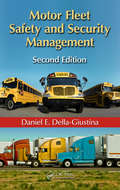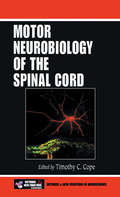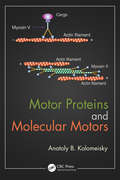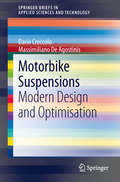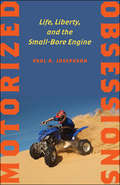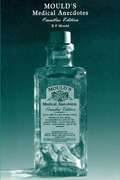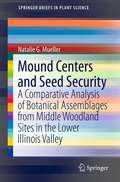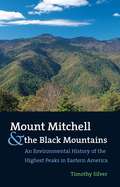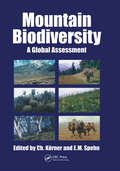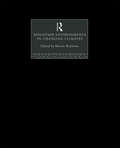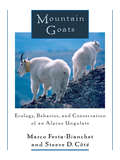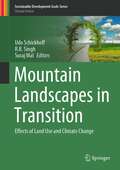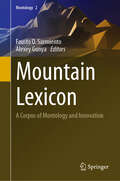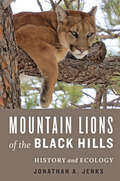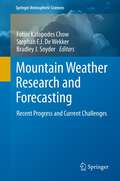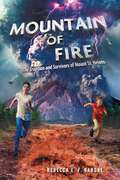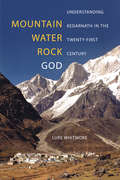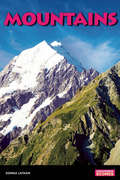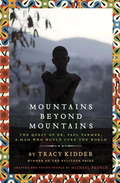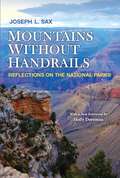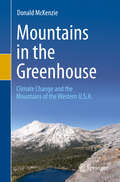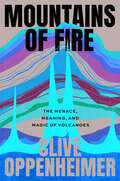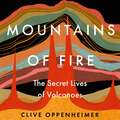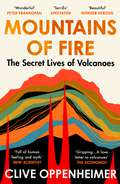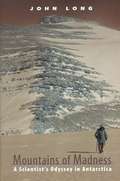- Table View
- List View
Motor Fleet Safety and Security Management
by Daniel E. Della-GiustinaIn the almost ten years since the publication of the first edition of Motor Fleet Safety and Security Management, the availability of new methods of transportation has made travel faster, and consequently, safety and security have become more important and more complex. Businesses must now become proactive in their own security and planning for eme
Motor Neurobiology of the Spinal Cord (Frontiers in Neuroscience)
by Timothy C. CopeMotor Neurobiology of the Spinal Cord provides a comprehensive description of the experimental tools available for investigating the neuronal properties that allow populations of spinal cord neurons to control muscles responsible for limb movements and posture control. By integrating data from many new approaches, this text demonstrates how spinal cord circuits operate under a variety conditions and explores the new and exciting developments that are being made in motor neurobiology of the spinal cord. It also elucidates concepts and principles relevant to function and structure throughout the nervous system and presents information about changes induced by injury and disease.
Motor Proteins and Molecular Motors
by Anatoly B. KolomeiskyA Unified Microscopic Approach to Analyzing Complex Processes in Molecular MotorsMotor Proteins and Molecular Motors explores the mechanisms of cellular functioning associated with several specific enzymatic molecules called motor proteins. Motor proteins, also known as molecular motors, play important roles in living systems by supporting cellular
Motorbike Suspensions
by Dario Croccolo Massimiliano De AgostinisAlthough they may look like simple components, the motorbike fork plays a critical role in the overall dynamic behaviour of motorcycles. It must provide appropriate stiffness characteristics, damping capabilities and the lowest sliding friction values in order to guarantee as much performance, safety and comfort as possible to the rider. Front Motorbike Suspensions addresses the fundamental aspects of the structural design of a motorbike fork. Utilizing the authors' many years of experience in this industrial research topic, Motorbike Suspensions provides useful design rules and applied mechanical design theories to optimize the shape of motorbike suspension. Overall structural considerations are explored alongside specific aspects including how bolted and adhesively bonded joints design can be applied to these components. R&D designers in the motorcycle industry who would like to improve their knowledge about the structural design of motorbike suspension will find Motorbike Suspension a concise and coherent guide to this specific feature. Whereas, undergraduates and graduates in industrial engineering matters may use this as a case study for an interesting application of the theories learned from machine design courses.
Motorized Obsessions: Life, Liberty, and the Small-Bore Engine
by Paul R. Josephson2008 Outstanding Academic Title, Choice MagazineFrom dirt bikes and jet skis to weed wackers and snowblowers, machines powered by small gas engines have become a permanent—and loud—fixture in American culture. But fifty years of high-speed fun and pristine lawns have not come without cost.In the first comprehensive history of the small-bore engine and the technology it powers, Paul R. Josephson explores the political, environmental, and public health issues surrounding one of America's most dangerous pastimes. Each chapter tells the story of an ecosystem within the United States and the devices that wreak havoc on it—personal watercraft (PWCs) on inland lakes and rivers; all-terrain vehicles (ATVs) in deserts and forests; lawn mowers and leaf blowers in suburbia. In addition to environmental impacts, Josephson discusses the development and promotion of these technologies, the legal and regulatory efforts made to improve their safety and environmental soundness, and the role of owners' clubs in encouraging responsible operation.Synthesizing information from medical journals, recent environmental research, nongovernmental organizations, and manufacturers, Josephson's compelling history leads to one irrefutable conclusion: these machines cannot be operated without loss of life and loss of habitat.
Mould's Medical Anecdotes: Omnibus Edition
by R.F MouldMould's Medical Anecdotes: Omnibus Edition is a fabulous collection of anecdotes on the humorous, intriguing, unusual, mysterious, and historical aspects of medicine. It combines the hugely successful Mould's Medical Anecdotes and More Mould's Medical Anecdotes and includes a selection of more recently collected material. Dr. Mould searched newspapers, advertisements, case histories, monologues, and medical journals on both sides of the Atlantic for this treasure trove.
Mound Centers and Seed Security
by Natalie G. MuellerAt Middle Woodland sites in the eastern United States, excavations have uncovered naturalistic art worked on exotic materials from points as distant Wyoming, Ontario, and the Gulf Coast, revealing a network of ritual exchange referred to as the Hopewell phenomenon. Simultaneously, Middle Woodland societies developed the earliest agricultural system in eastern North American using now-extinct native cultivars. Mound Centers and Seed Security: A Comparative Analysis of Botanical Assemblages from Middle Woodland Sites in the Lower Illinois Valley integrates an interpretation of these two historical trends. Unlike most journal articles on related subjects, the volume includes a lengthy review of literature on both Hopewell studies and Middle Woodland agriculture, making it a useful resource for researchers starting out in either field. Synthesizing both original research and research reported in archaeological "grey literature", Mound Centers and Seed Security: A Comparative Analysis of Botanical Assemblages from Middle Woodland Sites in the Lower Illinois Valley is a valuable tool for researchers and teachers alike.
Mount Mitchell and the Black Mountains
by Timothy SilverEach year, thousands of tourists visit Mount Mitchell, the most prominent feature of North Carolina's Black Mountain range and the highest peak in the eastern United States. From Native Americans and early explorers to land speculators and conservationists, people have long been drawn to this rugged region. Timothy Silver explores the long and complicated history of the Black Mountains, drawing on both the historical record and his experience as a backpacker and fly fisherman. He chronicles the geological and environmental forces that created this intriguing landscape, then traces its history of environmental change and human intervention from the days of Indian-European contact to today. Among the many tales Silver recounts is that of Elisha Mitchell, the renowned geologist and University of North Carolina professor for whom Mount Mitchell is named, who fell to his death there in 1857. But nature's stories--of forest fires, chestnut blight, competition among plants and animals, insect invasions, and, most recently, airborne toxins and acid rain--are also part of Silver's narrative, making it the first history of the Appalachians in which the natural world gets equal time with human history. It is only by understanding the dynamic between these two forces, Silver says, that we can begin to protect the Black Mountains for future generations.
Mountain Biodiversity: A Global Assessment
by Ch. Körner E. M. SpehnThis book is the result of the first global conference on mountain biodiversity, and is a contribution to the International Year of Mountains, 2002. The Global Mountain Biodiversity Assessment program is a Special Target Area Region project of DIVERSITAS (UNESCO and UNEP). Biological diversity is essential for the integrity of mountain ecosystems and this dependency is likely to increase as environmental (climate) and social conditions change. Steep terrain and climate, and severe land-use pressure cause mountain ecosystems to rank among the world's most endangered landscapes. The 28 chapters in this book represent research on the biological riches in all major mountain ranges of the world, and synthesize existing knowledge on mountain biodiversity - from diversity of bacteria, plants and animals to human diversity. The book is divided into five sections: an introduction providing an overview of the issues; plant and animal diversity; climate change and mountain biodiversity; land use and conservation; and a synthesis.
Mountain Environments in Changing Climates
by Martin BenistonHome to large numbers of people, sources of water, centres of tourism, and sensitive ecological zones, mountain environments share distinctive climactic characteristics. Once regarded as economically non-viable regions, mountains now attract major investment as sites of tourism, hydro-power and communication routes. This book brings together some of the current work on the physical and human ecology of mountain environments, the impacts of climate change, the processes involved and their observation and prediction.
Mountain Goats: Ecology, Behavior, and Conservation of an Alpine Ungulate
by Marco Festa-Bianchet Steeve D. CôtéMountain goats have been among the least studied of North American ungulates, leaving wildlife managers with little information on which to base harvest strategies or conservation plans. This book offers the first comprehensive assessment of the ecology and behavior of mountain goats, setting forth the results of a remarkable 16-year longitudinal study of more than 300 marked individuals in a population in Alberta, Canada. The authors' thorough, long-term study allowed them to draw important conclusions about mountain goat ecology--including individual reproductive strategies, population dynamics, and sensitivity to human disturbance--and to use those conclusions in offering guidance for developing effective conservation strategies. Chapters examine: -habitat use, vegetation quality, and seasonal movements -sexual segregation and social organization -individual variability in yearly and lifetime reproductive success of females -age- and sex-specific survival and dispersal -reproductive strategies and population dynamics -management and conservation of mountain goats The book also draws on the rich literature on long-term monitoring of marked ungulates to explore similarities and differences between mountain goats and other species, particularly bighorn sheep and ibex. By monitoring a marked population over a long period of time, researchers were able to document changes in sex-age structure and identify factors driving population dynamics. Because it explores the links between individual life-history strategy and population dynamics in a natural setting, Mountain Goats will be an invaluable resource for wildlife managers, researchers in ecology and animal behavior, conservationists, population biologists, and anyone concerned with the ecology and management of natural populations, especially in alpine environments.
Mountain Landscapes in Transition: Effects of Land Use and Climate Change (Sustainable Development Goals Series)
by R. B. Singh Udo Schickhoff Suraj MalThis book compiles available knowledge of the response of mountain ecosystems to recent climate and land use change and intends to bridge the gap between science, policy and the community concerned. The chapters present key concepts, major drivers and key processes of mountain response, providing transdisciplinary orientation to mountain studies incorporating experiences of academics, community leaders and policy-makers from developed and less developed countries. The book chapters are arranged in two sections. The first section concerns the response processes of mountain environments to climate change. This section addresses climate change itself (past, current and future changes of temperature and precipitation) and its impacts on the cryosphere, hydrosphere, biosphere, and human-environment systems. The second section focuses on the response processes of mountain environments to land use/land cover change. The case studies address effects of changing agriculture and pastoralism, forest/water resources management and urbanization processes, landscape management, and biodiversity conservation. The book is designed as an interdisciplinary publication which critically evaluates developments in mountains of the world with contributions from both social and natural sciences.
Mountain Lexicon: A Corpus of Montology and Innovation (Montology #2)
by Fausto O. Sarmiento Alexey GunyaThis book is the second volume in a series on montology dedicated to the transdisciplinary reflection of mountain research, considering the diversity of views on mountains and their problemata in the context of rapid technological development and unprecedented accumulation and dissemination of information around the world. The necessity for a new orderly and structured lexicon arose from the need to critically reassess the colonial past in the development of mountain territories, the development of a new and alternative understanding of mountain topics in the light of decolonized epistemology. The creation of coordinated and ordered terms for the main parts of mountain research creates the basis for an unorthodox understanding of the ontology of mountains and helps to better understand the complex cultural and natural essence of mountain socio-ecological systems. At the same time, a local episteme of mountains, considering local values, small scales, and vernacular visions are of particular importance, which must be taken into account in the current terminology. The purpose of the book is to provide methodological support for montology as a convergent and transdisciplinary science of mountains, based on the harmonization of its terminological base. The book pays special attention to onomastics, toponymy, standardization and other nuances of terms used in mountain research. According to this goal, three dozen articles in a relatively small format (about 3 pages) vividly, attractively and innovatively reflect the modern view of one or more related terms. Articles include definition(s) of the term, description of etymology, onomastics or toponymy used, examples of local characteristics compared to traditional sources, possible vernacular terms. Articles are grouped into four main areas: 1) Basic glossary of montology terminology, 2) Towards mountain socio-ecological systems, 3) Innovative disciplinary systemic realm, 4) Mountain classifications, onomastics, critical toponomy and rediscovery of meaning. The authors of the articles are leading experts in the field of mountain research from around the world. The book is intended for scientists, experts and teachers. It is provided with an annotated list of the most important montology terms.
Mountain Lions of the Black Hills: History and Ecology
by Jonathan A. JenksThe story of the recovery of mountain lions in the Black Hills of South Dakota.Mountain lions, sometimes called pumas or cougars, were once spread throughout the United States, occupying all 48 of the contiguous states. By the 1960s, though, they were almost extinct in central and eastern North America. In Mountain Lions of the Black Hills, Dr. Jonathan A. Jenks, who, along with his team of graduate students, has tracked over 200 of these fascinating predators, tells the complex story of the big cats’ lives in the northern Great Plains.Jenks reports on mountain lion population dynamics, diet, nutrition, diseases, behavior, and genetics. He explores the impact of a changing prey base on population growth and decline, movements within and away from the region, and hunting on the species; discusses interactions between the cats and livestock; and examines local people’s evolving perceptions of mountain lions. Throughout, Jenks explores how we can balance conservation techniques with the needs of humans.Providing a unique look into how a large, secretive predator recolonized an isolated region of North America, Mountain Lions of the Black Hills is required reading for wildlife professionals. A captivating text for anyone struck by the wild majesty of these big cats, this book provides invaluable data upon which to make sound management decisions in the Great Plains and beyond.
Mountain Weather Research and Forecasting
by Bradley J. Snyder Fotini K. Chow Stephan F.J. De WekkerThis book provides readers with a broad understanding of the fundamental principles driving atmospheric flow over complex terrain and provides historical context for recent developments and future direction for researchers and forecasters. The topics in this book are expanded from those presented at the Mountain Weather Workshop, which took place in Whistler, British Columbia, Canada, August 5-8, 2008. The inspiration for the workshop came from the American Meteorological Society (AMS) Mountain Meteorology Committee and was designed to bridge the gap between the research and forecasting communities by providing a forum for extended discussion and joint education. For academic researchers, this book provides some insight into issues important to the forecasting community. For the forecasting community, this book provides training on fundamentals of atmospheric processes over mountainous regions, which are notoriously difficult to predict. The book also helps to provide a better understanding of current research and forecast challenges, including the latest contributions and advancements to the field. The book begins with an overview of mountain weather and forecasting chal- lenges specific to complex terrain, followed by chapters that focus on diurnal mountain/valley flows that develop under calm conditions and dynamically-driven winds under strong forcing. The focus then shifts to other phenomena specific to mountain regions: Alpine foehn, boundary layer and air quality issues, orographic precipitation processes, and microphysics parameterizations. Having covered the major physical processes, the book shifts to observation and modelling techniques used in mountain regions, including model configuration and parameterizations such as turbulence, and model applications in operational forecasting. The book concludes with a discussion of the current state of research and forecasting in complex terrain, including a vision of how to bridge the gap in the future.
Mountain of Fire: The Eruption and Survivors of Mount St. Helens
by Rebecca E. BaroneMountain of Fire is the narrative nonfiction account of the violent volcanic eruption of Mount St. Helens on May 18, 1980, the story of the people who died, those who survived, and the heroes who fought to raise an alarm.For weeks, the ground around Mount St. Helens shuddered like a dynamite keg ready to explode. There were legends of previous eruptions: violent fire, treacherous floods, and heat that had scoured the area. But the shaking and swelling was unlike any volcanic activity ever seen before. Day and night, scientists tried to piece together the mountain’s clues—yet nothing could prepare them for the destruction to come. The long-dormant volcano seethed away, boiling rock far below the surface. Washington’s governor, Dixie Lee Ray, understood the despair that would follow from people being forced from their homes. How and when should she give orders to evacuate the area? And would that be enough to save the people from the eruption of Mount St. Helens?Includes a QR code for a website featuring eye-catching photos of the eruption.
Mountain, Water, Rock, God: Understanding Kedarnath in the Twenty-First Century
by Luke WhitmoreA free ebook version of this title is available through Luminos, University of California Press’s Open Access publishing program. Visit www.luminosoa.org to learn more. In Mountain, Water, Rock, God, Luke Whitmore situates the disastrous flooding that fell on the Hindu Himalayan shrine of Kedarnath in 2013 within a broader religious and ecological context. Whitmore explores the longer story of this powerful realm of the Hindu god Shiva through a holistic theoretical perspective that integrates phenomenological and systems-based approaches to the study of religion, pilgrimage, place, and ecology. He argues that close attention to places of religious significance offers a model for thinking through connections between ritual, narrative, climate destabilization, tourism, development, and disaster, and he shows how these critical components of human life in the twenty-first century intersect in the human experience of place.
Mountains
by Donna LathamInvestigating a variety of biomes and today's natural and human threats to their preservation, this interactive series challenges young readers to look at how their own actions influence the planet's health. Four distinct environments are explored in detail, showcasing the assortment of plants and animals that inhabit these outdoor communities as well as how they have adapted to their surroundings. Offering fascinating facts on each ecosystem along with vocabulary-building sidebars, these guides show budding scientists how they can contribute towards ongoing conservation efforts. The majesty of the earth's alpine biome is captured in this guide that discusses threats such as acid rain, climate change, and habitat destruction, clearly depicting how these factors affect the world's mountains.
Mountains Beyond Mountains (Adapted for Young People): The Quest of Dr. Paul Farmer, A Man Who Would Cure the World
by Tracy Kidder Michael FrenchMeet Dr. Paul Farmer, a Harvard-educated doctor with a self-proclaimed mission to transform healthcare on a global scale. Tracy Kidder follows Farmer's quest as he focuses his attention on some of the world's most impoverished people and uses unconventional ways in which to provide healthcare, to achieve real results and save lives.<P><P> Tracy Kidder's critically acclaimed adult nonfiction work, Mountains Beyond Mountains has been adapted for young people by Michael French. In this young adult edition, readers are introduced to Dr. Paul Farmer, a Harvard-educated doctor with a self-proclaimed mission to transform healthcare on a global scale. Farmer focuses his attention on some of the world's most impoverished people and uses unconventional ways in which to provide healthcare, to achieve real results and save lives.
Mountains Without Handrails: Reflections on the National Parks
by Joseph L. SaxBeloved by academic and general readers alike, Mountains Without Handrails, Joseph L. Sax’s thought-provoking treatise on America’s national parks, remains as relevant today as when first published in 1980. Focusing on the long-standing and bitter battles over recreational use of our parklands, Sax proposes a novel scheme for the protection and management of America's national parks. Drawing upon still controversial disputes—Yosemite National Park, the Colorado River in the Grand Canyon, and the Disney plan for California's Mineral King Valley—Sax boldly unites the rich and diverse tradition of nature writing into a coherent thesis that speaks directly to the dilemma of the parks. In a new foreword, environmental law scholar Holly Doremus articulates this book’s enduring importance and reflects on what Sax, her former teacher, might have thought about the encroachment of technology into natural spaces, the impact of social media, and growing threats from climate change. At this moment of great uncertainty for the national parks, Mountains Without Handrails should be read (and re-read) by anyone with a stake in America’s natural spaces.
Mountains in the Greenhouse: Climate Change and the Mountains of the Western U.S.A.
by Donald McKenzieThis book is written for general readers with an interest in science, and offers the tools and ideas for understanding how climate change will affect mountains of the American West. A major goal of the book is to provide material that will not become quickly outdated, and it does so by conveying its topics through constants in ecological science that will remain unchanged and scientifically sound. The book is timely in its potential to be a long-term contribution, and is designed to inform the public about climate change in mountains accessibly and intelligibly.The major themes of the book include: 1) mountains of the American West as natural experiments that can distinguish the effects of climate change because they have been relatively free from human-caused changes, 2) mountains as regions with unique sensitivities that may change more rapidly than the Earth as a whole and foreshadow the nature and magnitude of change elsewhere, and 3) different interacting components of ecosystems in the face of a changing climate, including forest growth and mortality, ecological disturbance, and mountain hydrology. Readers will learn how these changes and interactions in mountains illuminate the complexity of ecological changes in other contexts around the world.
Mountains of Fire: The Menace, Meaning, and Magic of Volcanoes
by Clive OppenheimerMeeting with volcanoes around the world, a volcanologist interprets their messages for humankind. In Mountains of Fire, Clive Oppenheimer invites readers to stand with him in the shadow of an active volcano. Whether he is scaling majestic summits, listening to hissing lava at the crater’s edge, or hunting for the far-flung ashes from Earth’s greatest eruptions, Oppenheimer is an ideal guide, offering readers the chance to tag along on the daring, seemingly-impossible journeys of a volcanologist. In his eventful career as a volcanologist and filmmaker, Oppenheimer has studied volcanoes around the world. He has worked with scientists in North Korea to study Mount Paektu, a volcano name sung in national anthems on both sides of the Demilitarized Zone. He has crossed the Sahara to reach the fabled Tiéroko volcano in the Tibesti Mountains of Chad. He spent months camped atop Antarctica’s most active volcano, Mount Erebus, to record the pulse of its lava lake. Mountains of Fire reveals how volcanic activity is entangled with our climate and environment, as well as our economy, politics, culture, and beliefs. These adventures and investigations make clear the dual purpose of volcanology—both to understand volcanoes for science’s sake and to serve the communities endangered and entranced by these mountains of fire.
Mountains of Fire: The Secret Lives of Volcanoes
by Clive OppenheimerA thrilling journey to the planet's most extreme places with volcanologist and filmmaker Professor Clive Oppenheimer, revealing how volcanoes have shaped us and our planet.Volcanoes mean more than threat and calamity. Like our parents, they've led whole lives before we get to know them. They have inspired our imaginations, provoked pioneering explorations and shaped the path of humanity.World-renowned volcanologist Clive Oppenheimer has worked at the crater's edge in the wildest places on Earth, from remote peaks in the Sahara to mystical mountains in North Korea. He's faced down AK47s, learned from tribal elders, and watched red hot rocks shoot into the sky. More people have been into space than have set eyes on the fiery depths of Mount Erebus in Antarctica, where he has measured the Earth's powerful forces. In Mountains of Fire, he paints volcanoes as otherworldly, magical places where our history is laid bare, and shows us just how entangled volcanic activity is with our climate, economy, politics, culture and beliefs.In a stunning blend of science, cultural history, myth and adventure, Mountains of Fire pulls out new lines of causation and correlation stretching around the globe, and reveals how deeply our stories are intertwined.(P) 2023 Hodder & Stoughton Limited
Mountains of Fire: The Secret Lives of Volcanoes
by Clive OppenheimerSHORTLISTED FOR THE BOARDMAN TASKER AWARD FOR MOUNTAIN LITERATURE'If Michael Palin had been a volcanologist, this is the book he would have written' LITERARY REVIEW'Gripping' THE ECONOMIST'Wonderful' PETER FRANKOPAN'Like a thriller ... This is terrific' SPECTATOR'Beautiful ... bursting with poetry, with storytelling' WERNER HERZOGWe are made of the same stuff as the breath and cinders of volcanoes. No matter where we live on the planet, they have shaped our history and might one day decide our destiny.World-famous volcanologist Clive Oppenheimer has worked at the crater's edge in the wildest places on Earth, close enough to feel the heat of the lava. In Mountains of Fire we join him on hair-singeing adventures from Italy to Antarctica to learn how deeply our stories are intertwined with volcanoes.
Mountains of Madness
by John Long Tim BowdenThis extraordinary book is the first-person account of John Long's two unforgettable "summers" on the southern continent. Told in a highly accessible and entertaining style, Mountains of Madness is the account of his three-month long fossil hunt. As the story unfolds, we learn of both the highs of scientific discovery as well as the grueling yet essential routines that must be practiced every day just to stay alive in one of the harshest environments on our planet. Alternating with the author's wonder at the intense beauty of his surroundings are his immense frustration and boredom that stem from being completely at the mercy of the elements.Throughout the course of the expedition, danger is never far off in this inhospitable land. Despite having been trained in the art of building snow caves and practiced in the skill of traversing glaciers, Long tells of two brushes with death in just one afternoon. The hair-raising escape from a deep crevasse is fraught with tension-only to be followed by yet another encounter with sudden disaster when the crash of an avalanche buries Long deep in the snow.
